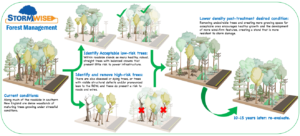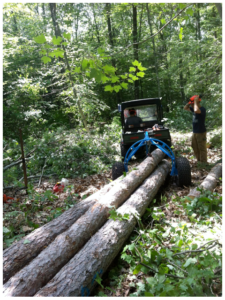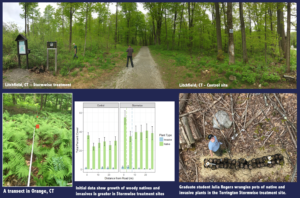A Partnership of UConn and Eversource
Eversource Energy Center
![]()
- Homepage
- >
- Tree & Forest Management
- >
- Roadside Forest Management
Roadside Forest Management
During the last 80-100 years of housing and infrastructure development across Southern New England, roadside woodlands have grown and aged in a generally unmanaged condition. Unmanaged forests tend to be overcrowded and trees in these areas must compete for water, sunlight and other resources. Less competitive trees can struggle and eventually fail and stands will thin themselves out naturally over time. Trees can also experience cumulative damage to their roots and crowns from storms over time, which will cause them to fail. Sometimes trees that have been sheltered, growing in close proximity with other trees (developing limited capacity to withstand wind) can be suddenly exposed to the full force of wind by some change in the canopy structure, including adjacent development, and they can easily fail as well. Insect and disease problems can also result in tree mortality in roadside woodlands.
Electric utility vegetation management calls for the trimming of trees within a narrow “protection zone” and while this activity addresses some of the potential outages that might be caused by trees, trimming is, at best, only a partial solution. During storms, many outages are caused by trees from within the unmanaged roadside woodlands, up to 100 feet away from the road and not necessarily from trees at the edge, within the utility tree-trimming range. Eversource and UConn are working together with Connecticut communities to develop long term roadside forest management solutions to reduce the potential for damage from this situation.
This research is focused on fostering wind-firm, storm resistant roadside woodlands where trees have adequate space and resources to grow healthy and robust. Careful, proactive roadside forest management can develop wind-firmness and maintain the aesthetic qualities and ecological benefits of these woodlands. Management activities can also reduce wood waste and support local wood industries, all while reducing outages and roadside maintenance costs. These ideas are the foundation of the Stormwise Program.
In addition, we are able to incorporate information from forest inventories, biomechanics work, and tree trimming or forest management history into the Outage Prediction Model. Along with weather data and simulations of past and future storms, this model will help to position resources at the time of a storm to ensure the quickest possible recovery from storm damage.
Eversource and UConn have worked closely with the Connecticut Agricultural Experiment Station, the US Forest Service, Connecticut Department of Energy and Environmental Protection and other partners to establish demonstration sites where Stormwise principles have been put into action. Stormwise Demonstration sites are typical of wooded roadsides around the state. They provide the ability to closely monitor the effects of vegetation management over time, and afford multiple educational opportunities, from the training of tree crews to educational workshops for members of the public.
Goals & Project Updates
The goal is to determine appropriate management strategies to foster roadside forests with diversity, density and structures that are wind resistant. We seek a long-term and comprehensive solution to address tree failure risk during severe storms using a combination of arboricultural and silvicultural (i.e., forest management) practices beyond just trimming. 4 tree-growing principals form the basis for the idea:
- Trees with adequate space to grow, like any plant, will be healthier trees.
- Trees that are free to move in the wind will develop wind-firmness.
- Tree branches and crowns grow towards sunlight and spaces in the canopy.
- The “right” tree can be grown in a particular place to avoid conflicts with infrastructure.
A specific management goal in many cases is to retain a partial canopy of taller trees that are healthy, straight, well-spaced and that have some longevity. Along with that, cultivate a sub-canopy of trees that will develop a shorter, broader, bushier appearance and create conditions favoring the establishment of younger trees to work with in the future. While forest management objectives should be devised on a case-by-case basis, the following is a typical example of a Stormwise forest management treatment:
Further research goals include:
- Testing the opportunities for and limitations of small scale harvesting and primary processing of Connecticut timber, as applied to implementing Stormwise management recommendations.
- Examining the opportunities for and limitations of portable band sawmills, to play a role in small-scale wood product value recovery.
Established Demonstration Sites as of Spring, 2018:
- Storrs, CT. UConn Forest Fenton Tract.
- Mansfield, CT. UConn Forest Spring Hill Tract, Chaffeeville Rd.
- Coventry, CT. Nathan Hale State Forest, Seagraves Rd.
- Voluntown, CT. Patchaug State Forest, Beach Pond Rd.
- East Hampton, CT. Meshomasic State Forest, Gadpouch Rd.
- Litchfield, CT. White Memorial Foundation, Litchfield Rd.
- Torrington, CT. UConn Forest, Torrington Campus, University Drive.
- Orange, CT. South Central Regional Water Authority property, Greenway Rd.
- Prospect, CT. Connecticut Water Company, Talmadge Rd. and Rt 69.
- Trumbull, CT. Connecticut DOT, Rt. 25
- Durham, CT. Connecticut Forest and Park Association, Bear Rock Rd.
Demonstration sites were identified and treated by the Uconn forest crew or our partners on the Stormwise project from the Connecticut Agriculture Experiment Station.
Additional demonstration areas proposed:
- North side of North Eagleville Rd. in Storrs, near the Bone Mill Rd. intersection
- Along Gurleyvill Rd., in Storrs
Updates and Activities:
- 3 of the established sites are set up for biomechanics research
- 8 of the sites are used for edge-effects research
- Dozens of presentations and more than a half-dozen field workshops regarding Stormwise and roadside forest management have been presented to various land management groups around the state
- 2 municipal value recovery pilot projects (for the recovery of wood product removed during roadside management) have been initiated
Research Project: Impact of Forest Management on Understory Edge Effects in Roadside Forests
Edge effects are changes to processes and species diversity along the edge into the forest. The edge has a large influence on tree and seedling mortality and somewhat lesser but still important effects on species richness and abundance. Forest management, particularly in the unique community of the roadside forest, may enhance the edge effects acting on plant communities.
In 8 of the Stormwise demonstration sites in CT a section of roadside forest was cut according to the Stormwise treatment and a section was left untouched (control). Within each section of forest, 3 transects were established running perpendicular to the road, 30m long, 30m from an edge (other than the road), and 10m from one another. Along the transects, each of the following were tracked throughout the growing season.
1) Woody plants (in 4m wide belts along the transects)
2) Herbaceous plants (in 1-sq-m plots along transects)
3) Light conditions (looked at with a ceptometer, as well as hemispherical photos along the transects)
Edge Effects Research: Goals & Project Updates
The objectives of this study are to quantify the depth of road edge effects and environmental conditions in Stormwise treatment sites compared to control treatments throughout Connecticut. Specifically, between the management and control sites, we want to look at:
1) Differences in native versus invasive plant communities
2) Differences in the plant community structure and composition
3) Differences in light environments
ü Depth-of-Edge Influence Analyses have been developed (Harper and MacDonald 2011) to test the significance of the magnitude of the edge influence at various distances from the edge, as compared to what would be expected in an interior forest plot.
ü Preliminary results have shown us that the Stormwise treatments enhance the edge effects in the roadside forests, which was expected. Stormwise treatments are also promoting the growth of woody vegetation, both invasive and native, in the roadside forest. However, there is a lack of edge influence in control sites, indicating that the forests have had time to seal the edge following the establishment of the road.
ü Phase 2 of the project, now underway, will involve a close look at the growth and development of native and invasive species growing in the Stormwise treatment sites as well as controls.

|
Team Members
| Thomas Worthley, Associate Extension Professor, Forest Resources, University of Connecticut |
| Jeffrey Ward, CT Agricultural Experiment Station – New Haven, CT |
| Amanda Bunce, Graduate Student, Department of Natural Resources and the Environment, University of Connecticut |
| Nicholas Cranmer, Graduate Student, Department of Natural Resources and the Environment, University of Connecticut |
| John Volin, Department Head, Natural Resources and the Environment, University of Connecticut |
| Sean Redding, Manager - Vegetation Management, Eversource Energy |
Contact Information
|
Thomas E. Worthley, Associate Extension Professor, UConn Extension (thomas.worthley@uconn.edu) Members of the media, please contact Center Manager Diego Cerrai (diego.cerrai@uconn.edu) directly. |
Eversource Energy Center | Innovation Partnership Building: 159 Discovery Drive, Unit 5276, Storrs, CT 06269-5276 | E-Mail: eversourceenergycenter@uconn.edu


